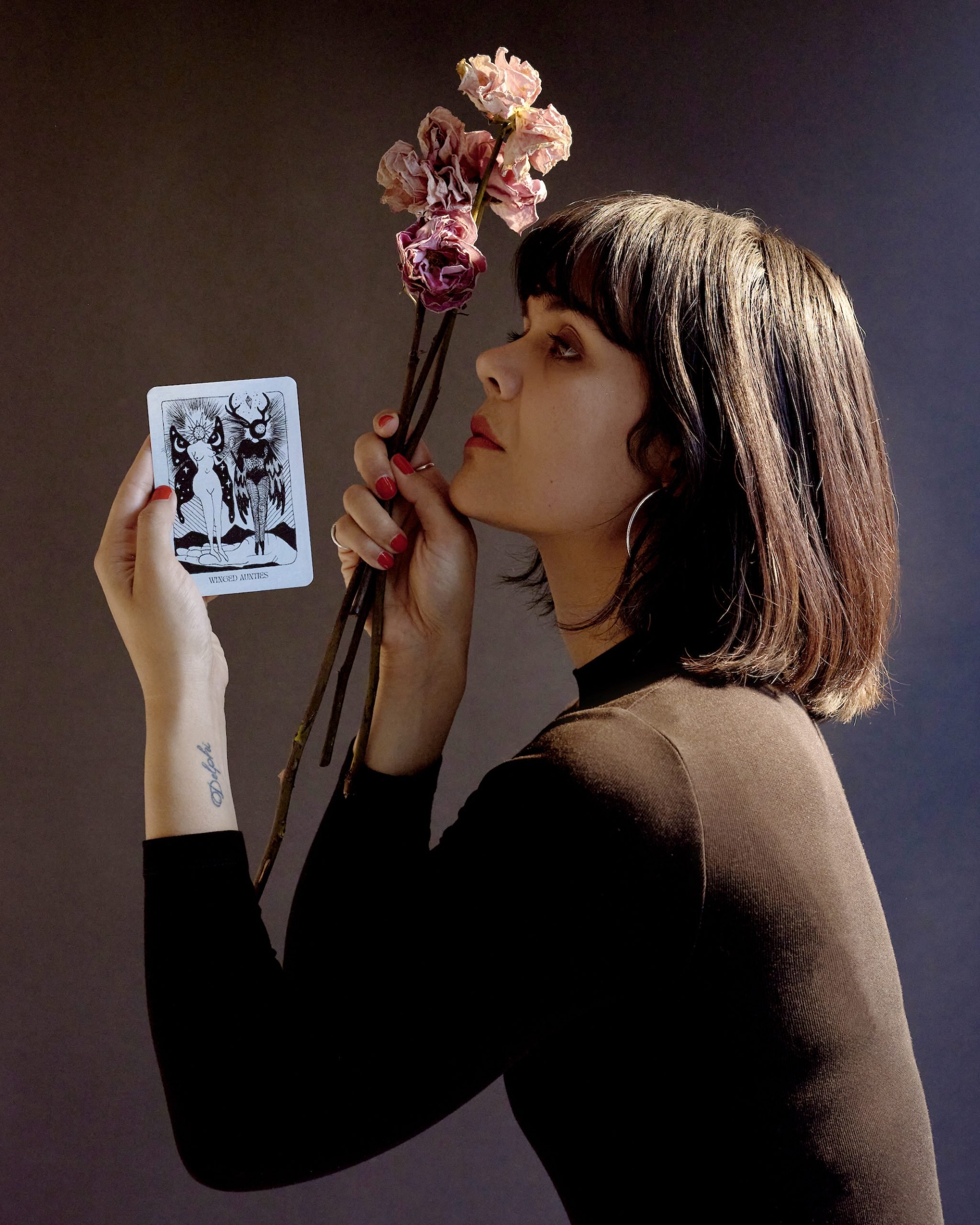
To Natasha Khan, the mystical realm is never far off. It drew her in as a teenager, when she cultivated a curiosity around the paranormal, and it has infused her art and music, the latter of which has seen her perform for years under the moniker Bat for Lashes. “To me,” she said over Zoom, “music is mystical because it’s invisible.”
More recently, Khan’s engagement with the transcendent has taken on another form: an oracle card deck that she single-handedly illustrated and designed. Called Motherwitch, the deck sees Khan reimagine the Tarot, deploying various “feminine aspects” as visual symbols. Seekers can use the 40-card set in spiritual practices or as a creative prompt, à la Brian Eno and Peter Schmidt’s Oblique Strategies deck.
Khan started drawing the cards over the 2020 lockdowns, filling an entire Moleskine notebook with her illustrations while she was pregnant with her first child, Delphi. The approach of motherhood, she said, sparked in her a nurturing instinct that fed into the art.
“I felt that there was this overarching matriarchal desire to contain and hold people in their creative or life process,” she said. “After becoming a mother, I wanted to share my wisdom, practices, and rituals to reconnect people with a healthy maternal energy.”
The Motherwitch oracle card deck, with accompanying guidebook, by Bat for Lashes. Photo courtesy of She’s Lost Control.
Hence Motherwitch’s array of female archetypes—witches, sirens, mothers, angels—intended to serve as guides through inner landscapes. The card of Childhood, for instance, shows a young girl alongside a donkey, her familiar, standing amid a verdant jungle that’s “all about going back to that place of exploration and innocence, the re-enchantment of imagination,” said Khan.
While the work of Hilma af Klint and Agnes Martin served as guiding lights for Motherwitch’s art, illustrating the deck was also an instinctive, almost unconscious, gesture. Khan described it as “letting the process happen to me,” allowing her hand to take the lead and drawing without judgement. The “trance-like, half-asleep state” she experienced between breastfeeds helped too.
“I just was following my hand,” she explained. “It was about not interfering with [the work] and letting it reveal itself without any kind of ego worries getting in the way. I think that’s the same process I apply to music.
While Khan was trained in both visual arts and music at Brighton University in 2000, she’s come to be better known for her work as Bat for Lashes. Her musical practice has seen her release increasingly conceptual records that entwine fantastical narratives with her ghostly baroque pop—from the folkloric sweep of Two Suns (2009) to the tragic heroine that anchors The Bride (2016). They’re albums for which Khan has constructed worlds, characters, myths.
“I love to create universes. It’s all about storytelling—fairy tales, old folk tales,” she said. “There’s always been very specific worlds that I’ve wanted to inhabit or characters I’ve dressed up as. Themes, colors, and styles—all those things have been part of Bat of Lashes.”
The Childhood card, part of the Motherwitch oracle card deck by Bat for Lashes. Photo courtesy of She’s Lost Control.
For Motherwitch, Khan has likewise built entire worlds around each of her oracle cards. The deck is accompanied by a guidebook, which she also wrote, containing descriptions (or “manifestos”) of each card and suggestions for connected rituals and artistic echoes, whether it be an artwork, film, or song.
The Desert Witch, for instance, is characterized as “a keeper of nomad tales,” and seekers are asked to “receive your own psychic gift from the atmosphere” or find a similar oracle in the 2015 film Ma. The Cosmic Seed card encourages connection and conversation, with a suggested soundtrack of Kate Bush’s “Hello Earth.”
Asked to pick the oracle cards that are most resonant for her, Khan pointed to Childhood (which is inscribed with the letter “d,” a tribute to her daughter) and the Mushroom King (“a celebration of native sacred masculine energy”). But fittingly, she also drew the Theremin Sorceress.
The Theremin Sorceress card, part of the Motherwitch oracle card deck by Bat for Lashes. Photo courtesy of She’s Lost Control.
“This is about electricity and psychic abilities,” said Khan of the card. “She’s playing a theremin, so it’s all about invisible things and how energy conducts, attracts, repels, and communicates.”
Described in the guidebook as “an electric transcendentalist,” the card asks its holder to harness the energy of “etheric force fields,” paired with a visual serving of af Klint’s Group X, No. 1, Altarpiece (1915). “Music and love are invisible,” it instructs, “but they have the power to move worlds.”
More Trending Stories:
Four ‘Excellently Preserved’ Ancient Roman Swords Have Been Found in the Judean Desert